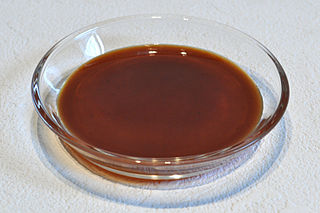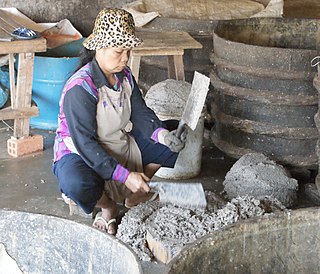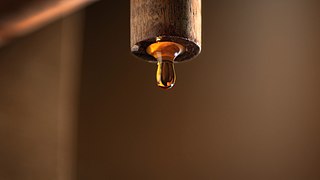
Worcestershire sauce is a fermented liquid condiment created in the city of Worcester in Worcestershire, England, in the first half of the 19th century. The creators were the chemists John Wheeley Lea and William Henry Perrins, who went on to form the company Lea & Perrins. Worcestershire sauce has been considered a generic term since 1876, when the English High Court of Justice ruled that Lea & Perrins did not own the trademark to "Worcestershire".

Fish paste is fish which has been chemically broken down by a fermentation process until it reaches the consistency of a soft creamy purée or paste. Alternatively it refers to cooked fish which has been physically broken down by pounding, grinding, pressing, mincing, blending, and/or sieving, until it reaches the consistency of paste. The term can be applied also to shellfish pastes, such as shrimp paste or crab paste.

Bagoóng is a Philippine condiment partially or completely made of either fermented fish or krill with salt. The fermentation process also produces fish sauce known as patís.

A number of condiments and sidedishes are used in Filipino cuisine. They include:

Bagoong monamon, bagoong monamon-dilis, or simply bagoong and bugguong munamon in Ilocano, is a common ingredient used in the Philippines and particularly in Northern Ilocano cuisine. It is made by fermenting salted anchovies which is not designed, nor customarily used for immediate consumption since it is completely raw.

Bagoong Terong or bagoong, and bugguong in the Ilocano language, is a common ingredient used in the Philippines and particularly in Northern Ilocano cuisine. It is made by salting and fermenting the bonnet mouth fish. This bagoong is coarser than Bagoong Monamon, and contains fragments of the salted and fermented fish ; they are similar in flavor. The odor is distinct and unique. Those who are unfamiliar with this condiment may find the smell repulsive. Bagoong is an essential ingredient in many curries and sauces. Fish sauce, common throughout Southeast Asian cuisine, is a by-product of the bagoong process. Known in the Philippines as patis, it is distinguished as the clear refined layer floating on the thicker bagoong. Patis and bagoong can be interchanged in recipes, depending on personal taste and preference.

Neapolitan cuisine has ancient historical roots that date back to the Greco-Roman period, which was enriched over the centuries by the influence of the different cultures that controlled Naples and its kingdoms, such as that of Aragon and France.

Marinara sauce is a tomato sauce, usually made with tomatoes, garlic, herbs, and onions. Its many variations can include the addition of capers, olives, spices, and a dash of wine.
Murrī or almorí was a condiment made of fermented barley or fish used in medieval Byzantine and Arab cuisine.

Surströmming is a lightly-salted fermented Baltic Sea herring.
Phu Quoc fish sauce is a variety of fish sauce produced on Phu Quoc island in southwest Vietnam. Since 2001, the Industrial Property Department of the government of Vietnam has the name "Phu Quoc Fish Sauce" as a trademark, and only registered manufacturers are allowed to use the name in Vietnam. Such protection, however, does not extend worldwide. In 2012, Phu Quoc fish sauce was granted a European Union Protected Designation of Origin (PDO) status.

Anchovies are small, common saltwater forage fish in the family Engraulidae that are used as human food and fish bait. There are 144 species in 17 genera found in the Atlantic, Indian, and Pacific Oceans. Anchovies are usually classified as an oily fish. They are small, green fish with blue reflections due to a silver longitudinal stripe that runs from the base of the caudal fin. They range from 2 centimetres (0.79 in) to 40 centimetres (16 in) in adult length, and the body shape is variable, with more slender fish in northern populations.

Anchovy paste is a fish paste food product prepared using anchovies as a primary ingredient. It is used as a condiment and as an ingredient in various dishes, such as Scotch woodcock, and is a mass-produced product. It has been used for centuries to provide flavor to foods and as a source of nutrients, and it is a part of the cuisines of Great Britain, Italy, the Philippines and Vietnam. It is a major export product of Morocco.

















